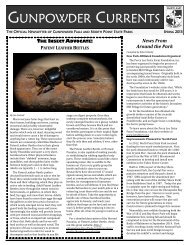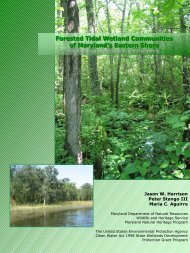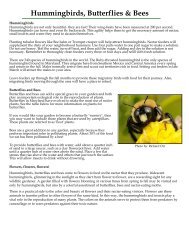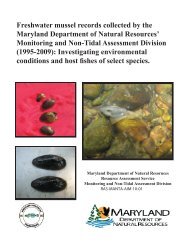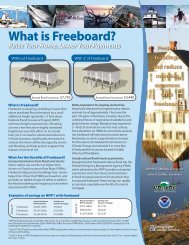Do mountain LIONS IN OUR MOUNTAINS? - Maryland Department ...
Do mountain LIONS IN OUR MOUNTAINS? - Maryland Department ...
Do mountain LIONS IN OUR MOUNTAINS? - Maryland Department ...
You also want an ePaper? Increase the reach of your titles
YUMPU automatically turns print PDFs into web optimized ePapers that Google loves.
<strong>LIONS</strong> <strong>IN</strong> <strong>OUR</strong> MOUNTA<strong>IN</strong>S?<br />
The Mystery of Cougars in <strong>Maryland</strong><br />
by Glenn Therres<br />
<strong>Do</strong> <strong>mountain</strong><br />
lions roam the<br />
wilds of <strong>Maryland</strong>?<br />
This is an unsolved mystery.<br />
Historically, <strong>mountain</strong> lions once<br />
inhabited the wilderness of our state.<br />
Also known as cougar, puma, or<br />
panther, these native big cats lived throughout<br />
<strong>Maryland</strong> when the first colonists arrived. As<br />
<strong>Maryland</strong> was settled, the forests<br />
were cleared and our <strong>mountain</strong><br />
lions started to disappear. The<br />
early settlers shot the big cats<br />
because these predators killed<br />
deer and livestock. Cougars were<br />
feared and thus, persecuted. By<br />
the mid-1800s, the <strong>mountain</strong><br />
lions had disappeared from all but<br />
the remote <strong>mountain</strong>ous areas of<br />
western <strong>Maryland</strong>.<br />
In the late 1800s, the last of<br />
<strong>Maryland</strong>’s remnant population<br />
of cougars is thought to have<br />
disappeared. At that time, the<br />
white-tailed deer population (the<br />
principal prey species of this big<br />
cat) was reduced considerably by<br />
market hunters and homesteaders.<br />
Also, the extensive forests in<br />
western <strong>Maryland</strong> were logged<br />
for lumber and charcoal. The<br />
combination of these two factors,<br />
plus the continued persecution of<br />
this “vermin,” made it nearly impossible for the<br />
species to survive. This same scenario was played<br />
out throughout the Appalachian Mountains and<br />
elsewhere in eastern North America.<br />
The eastern cougar was declared an endangered<br />
species by the U.S. Fish & Wildlife Service in<br />
<strong>Do</strong>n MacCarter UMMZ<br />
WILDLIFE & HERITAGE<br />
1973. In the 1970s, the U.S. Fish & Wildlife<br />
Service tried to confirm the presence of eastern<br />
cougars in the Appalachian Mountains, but was<br />
not able to do so. The only remnant population<br />
in the eastern part of the continent is the<br />
endangered Florida panther.<br />
Today, we still receive reports of <strong>mountain</strong><br />
lions, cougars, and even black panthers in<br />
<strong>Maryland</strong>. All the other states in the east receive<br />
similar reports. Is there a remnant population of<br />
<strong>mountain</strong> lions in <strong>Maryland</strong>? That’s a $64,000<br />
question.<br />
Carnivorous Cats<br />
Mountain lions are the largest member of the<br />
cat family in North America. An adult cougar<br />
can weigh 150 pounds. They stand 2½ feet tall<br />
and their bodies are 4 to 5 feet long with long<br />
tails adding another 2 to 3 feet to their length.<br />
12 v The <strong>Maryland</strong> Natural Resource v www.dnr.maryland.gov<br />
Adult cougars are tawny in color with no spots.<br />
No black cougars have ever been documented<br />
from North America.<br />
Cougars are the number one large predator<br />
in the western United States, occurring from<br />
the Rocky Mountains to the Pacific Ocean.<br />
This western population is expanding eastward,<br />
with confirmations in Kansas, South Dakota,<br />
and Texas. The only known population of<br />
cougars east of the Mississippi River is in<br />
Florida, where less than 100 animals persist.<br />
There have been a dozen or so confirmations<br />
of individual cougars in the east,<br />
but no known populations have<br />
been documented. Northern<br />
Delaware was the location of<br />
confirmed cougar sightings in<br />
2002, but it is believed that<br />
those animals had escaped from<br />
captivity.<br />
<strong>Do</strong> these<br />
predators<br />
persist?<br />
The Cougar Network is an<br />
organization that tracks verifiable<br />
cougar sightings. They consider<br />
two types of confirmations.<br />
One type is when a cougar is<br />
captured or recovered dead,<br />
DNA evidence is found, or<br />
photographs are unquestionably<br />
that of a <strong>mountain</strong> lion. The<br />
second type of confirmation is<br />
when tracks or other physical<br />
evidence are verified by qualified<br />
professionals.<br />
In <strong>Maryland</strong>, we receive a dozen to two dozen<br />
reports a year from citizens who see, hear or<br />
find signs of cougars. Or so they think! Reports<br />
come from throughout the state, though most<br />
come from western <strong>Maryland</strong> or the suburbs
of Baltimore and Washington. All reports are<br />
logged into a database. The <strong>Department</strong> of<br />
Natural Resources (DNR) has received over 150<br />
reports in the past seven years. Many sightings<br />
are a glimpse of an animal darting across the<br />
road or into the woods, most without the aid of<br />
binoculars or camera.<br />
Here are a few examples of reports received:<br />
• Saw what appeared to be a large black cat.<br />
The animal was walking along the shoulder of<br />
the road. It was distinguishable from a dog by<br />
its long tail that curved up at the end. It also<br />
lacked a long snout that most canines possess.<br />
• Saw a large cat the size of a German<br />
shepherd or larger dog walking down the<br />
trail. It was much too large to be any other<br />
type of normal cat and it was not a bobcat.<br />
It had a long tail and was yellowish/brown<br />
in color. The tip of the tail was very round<br />
and was white on the tip.<br />
• A large animal bounded across the road. It<br />
was about the size of a large dog, but had<br />
a gait of a cat. It moved very quickly and<br />
jumped over a roadside guard rail.<br />
Though it would seem fairly easy to identify<br />
a full-grown <strong>mountain</strong> lion, is it? It’s hard to<br />
misidentify an adult bald eagle, but it happens<br />
all the time. We receive reports of bald eagles<br />
that turn out to be osprey, hawks, black-backed<br />
gulls, and even pigeons.<br />
The Bobcat <strong>Maryland</strong>’s <strong>Do</strong>cumented ‘Big’ Cat<br />
By Robert Colona<br />
Although unconfirmed sightings of<br />
<strong>mountain</strong> lions and black panthers<br />
persist, the bobcat (Felis rufus) is<br />
the only resident ‘big’ cat with established<br />
populations in <strong>Maryland</strong>. Contrary to the<br />
somewhat mystical aura that tends to surround<br />
bobcats, they are relatively common throughout<br />
portions of <strong>Maryland</strong> and thrive in a variety of<br />
altered landscapes. However, they are extremely<br />
elusive and rarely glimpsed, even in areas with<br />
large populations or when they reside in close<br />
proximity to humans.<br />
Bobcats range from Garrett County eastward<br />
to the western shore of the Chesapeake Bay.<br />
Non-verified sightings also occur occasionally<br />
on the Eastern Shore. The highest population<br />
densities are found in Garrett and Allegany<br />
Counties, followed by Washington and Frederick<br />
Counties.<br />
Bobcats resemble domestic cats with a few<br />
notable exceptions. They are approximately twice<br />
as large, stockier built, have pointed black ear<br />
tufts and short tails with a distinct dark band<br />
near the tip. A great deal of pelage (fur) variation<br />
occurs in bobcats -- their overall coloration is<br />
brown ranging from grayish brown to yellowish<br />
and reddish brown with an interspersion of dark<br />
stripes and spots. Their undersides are typically<br />
white and contain random dark spots and their<br />
faces are fringed in a ruff of longer fur. These big<br />
cats can range from 29 to 39 inches in length<br />
and can weigh anywhere from 10 to over 40<br />
pounds, with males usually one-third larger<br />
than females.<br />
Breeding season extends from January through<br />
April, and gestation ranges from 50 to 70 days,<br />
with 62 or 63 being most common. Litters range<br />
from 1 to 6, with an average of 2 or 3 kittens.<br />
Bobcats do not make dens; instead they will<br />
utilize brush and woody debris piles, hollow<br />
logs, overturned trees, rock crevices and isolated<br />
human structures.<br />
Bobcats occupy many habitat types; however<br />
a large component of dense vegetative cover<br />
and/or understory development is critical<br />
regardless of the location. In heavily forested<br />
areas, interspersed openings including swamps<br />
and bogs, clear-cuts, small farm fields, dirt roads,<br />
power lines, rocky slopes and other ‘disturbed’<br />
sites that promote early successional growth are<br />
selected. In agricultural areas, they tend to choose<br />
timbered bottomland habitat containing early<br />
successional openings as mentioned above.<br />
Bobcats are truly carnivorous, consuming very<br />
little vegetative material. They feed primarily<br />
on small mammals, birds, rabbits and squirrels.<br />
However, when the opportunity is presented they<br />
will eat larger animals including adult deer.<br />
Historically bobcats were distributed<br />
statewide but during the post colonization<br />
period densities began to plummet. By the<br />
mid-1900s, populations had probably reached<br />
all-time lows, with remnant populations existing<br />
only in western <strong>Maryland</strong>. This prompted the<br />
Disappearing Act<br />
Evidence has also been provided, but none that<br />
is conclusive. Many times we receive photos<br />
of tracks or, on occasion, casts of tracks. Our<br />
technicians have also gone and looked at tracks<br />
thought to be that of <strong>mountain</strong> lions. Most turn<br />
out to be canine tracks, either of dogs or coyotes.<br />
Though canine tracks usually show their claw<br />
marks, and cat tracks usually do not show claw<br />
marks, there are exceptions. Proper identification<br />
requires attention to details.<br />
On rare occasion, someone video tapes or gets<br />
a photo of a “cougar.” I have seen five such videos<br />
in the past 15 years. In two, it was relatively<br />
easy to determine that the animal in question<br />
was not a cougar. However, one video taken by<br />
<strong>Department</strong> of Natural Resources (DNR) to<br />
classify them as a state-listed “Species of Special<br />
Concern.” During the past quarter century,<br />
occupied range and densities have increased<br />
markedly. Results from the annual Bowhunter<br />
Survey and the Hunter Mail survey have<br />
identified bobcat sightings in 14 of <strong>Maryland</strong>’s<br />
23 counties. Currently, bobcats have dual legal<br />
classification in <strong>Maryland</strong>. In addition to the<br />
Species of Special Concern designation, they are<br />
also defined as a Game Animal / Furbearer with<br />
a closed harvest season.<br />
The future looks promising for this beautiful<br />
animal. Conservation measures adopted by<br />
DNR coupled with the adaptability of this<br />
resilient species have resulted in ever expanding<br />
populations. v<br />
Robert Colona is the Furbearer Project Leader<br />
for DNR’s Wildlife & Heritage Service.<br />
Fall 2007 v 13<br />
Conrad Fijetland USFWS
Lazette Gifford UMMZ<br />
a landowner in Garrett County cannot be ruled<br />
out completely. We concluded that the animal<br />
appeared to be a “big cat” though we could not<br />
confirm it to be a <strong>mountain</strong> lion. That video was<br />
later shown on <strong>Maryland</strong> Public Television and<br />
the interview that aired along with the footage<br />
of the big cat raised some doubt.<br />
Another video from Garrett County showed<br />
a cat that appeared to be large walking along a<br />
hedgerow. Unfortunately, the lighting was less<br />
than ideal and we were not able to positively<br />
identify the animal. Most recently, we received<br />
a digital video clip of an animal that might be a<br />
cougar or might be a deer. The image quality was<br />
too poor to positively identify the animal.<br />
If <strong>mountain</strong> lions were<br />
extirpated from <strong>Maryland</strong><br />
by the start of the 1900s,<br />
then what are people seeing?<br />
Recently, someone reported<br />
seeing a <strong>mountain</strong> lion at the<br />
site of a fresh deer kill. One of<br />
our technicians investigated.<br />
He found the dead deer<br />
covered by leaves, which is<br />
characteristic of a cat kill.<br />
He placed a trail camera at<br />
the site and got great photos of a bobcat during<br />
the night.<br />
Coyotes dashing across the road can be<br />
mistaken for <strong>mountain</strong> lions. They are tan in<br />
color with long tails. Fishers in western <strong>Maryland</strong><br />
can be misidentified as black panthers. Even large<br />
house cats can be mistaken for cougars in poor<br />
light or at a distance. Many of the reports turn<br />
out to be dogs or large house cats.<br />
Could there be a <strong>mountain</strong> lion or two<br />
roaming the wilds of <strong>Maryland</strong>? Sure there<br />
could be. It is not hard to find <strong>mountain</strong> lions<br />
for sale on the internet, though it is illegal to<br />
possess one in <strong>Maryland</strong>. We have trapped<br />
alligators, caimans, and wallabies from the wild<br />
in <strong>Maryland</strong>, so it is not inconceivable that a<br />
former pet cougar could be out there.<br />
In the case of <strong>mountain</strong> lions, it will be<br />
hard to distinguish between a former captive<br />
animal and true native cat. Before we tackle<br />
that question, one must be documented with<br />
conclusive evidence in <strong>Maryland</strong>. Keep your<br />
eyes open! v<br />
Glenn Therres is a Program Manager with<br />
DNR’s Wildlife and Heritage Service.






